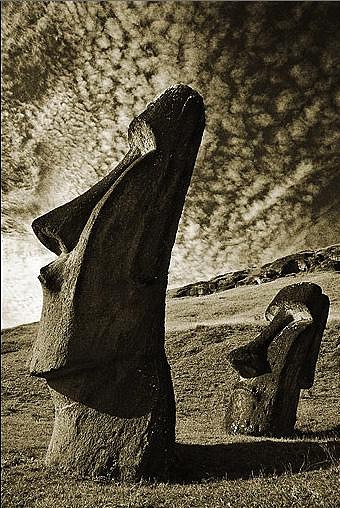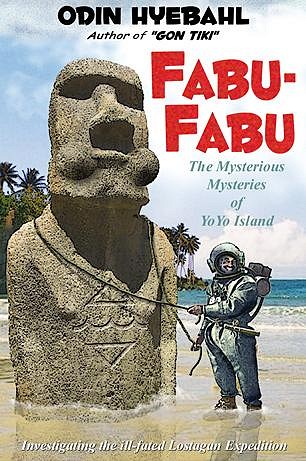Pages: 1 30 replies
|
H

hanford_lemoore
Posted
posted
on
Mon, Sep 5, 2005 1:55 AM
For my Savage Renewal: Archaeology Topic I thought I'd share some amazing photos of an Easter Island Moai Raising that took place during Thor Heyerdahl's (first?) visit to Rapa Nui. These photos come straight out of my hardcover American edition of Aku-Aku by Thor Heyerdahl. In the book, Thor convinces the Mayor of Rapa Nui to teach him his ancestor's secret of moving and raising the giant Moai statues into place. Over eighteen days, the mayor and his crew show Thor how it was done. These images are very cool -- real Easter Island natives raising a Moai into place. There's more photos in the book and if people like these I can scan more. (Sorry for the scan errors) Below each photo I've posted the actual captions from the book.
[ Edited by: hanford_lemoore 2005-09-05 01:59 ] |
|
H
hewey
Posted
posted
on
Mon, Sep 5, 2005 6:08 AM
Cool pics! Ive seen diagrams, but those photos are so much cooler. Pitty the place looks like a desert :) |
|
H
harro
Posted
posted
on
Mon, Sep 5, 2005 6:38 AM
hey there.. |
|
C
christiki295
Posted
posted
on
Mon, Sep 5, 2005 9:22 AM
Mahalo, Hanford, for such a complete photoessay. I need to get that book. |
|
C
christiki295
Posted
posted
on
Mon, Sep 5, 2005 9:25 AM
Tikibars has, twice, and previously posted his link: If you go to my web site at http://www.tydirium.net you will find a 42-page account of my trip to Easter Island in May of 2000. I believe I can say without fear of dispute that this is the most detailed first-person portrait of Rapa Nui that a TC'er will be able to provide for you |
|
T

tikibars
Posted
posted
on
Mon, Sep 5, 2005 11:59 AM
Thankks for posting the link to my site, Christiki. That travelogue is from my 2000 trip. Here are postings and pics right here on TC from the 2004 trip that Dangergirl and I took: http://www.tikicentral.com/viewtopic.php?topic=11815&forum=1&hilite=iorana |
|
G
Gigantalope
Posted
posted
on
Mon, Sep 5, 2005 12:44 PM
About 15 years ago some students from the university of Prague had a theory that the heads were moved with tubors which acted as a babit bearing rather than the traditional theory of the logs as rollers. To prove it they made a cement head of roughly the same weight and dimensions and pushed it around town using potatoes. It only took a few people to move the head with the spuds...it was amazing (and quite funny) Great photos! |
|
H
harro
Posted
posted
on
Mon, Sep 5, 2005 8:05 PM
thankyou christiki, dangergirl and tikibars for the links - i knew there would be some very informative and helpful people here! tikibars i have read your thread from your 2004 trip and look forward to reading the EPIC that is the 42pg travelogue from your 2000 trip (might need a spare day or two and a few mugs of coffee for that one!). the photos and info even on a quick scan are fantastic! look forward to reading it more in detail when i begin to organise this trip soon. cheers! |
|
PT
Palama Tiki
Posted
posted
on
Tue, Sep 6, 2005 10:50 AM
Great stuff, Hanford! Thanks! |
|
S
saxotica
Posted
posted
on
Tue, Sep 6, 2005 3:28 PM
I have a question; maybe somebody knows the answer.If the Europeans found Easter Island deserted, how are there native Rapa Nuians? |
|
S
saxotica
Posted
posted
on
Tue, Sep 6, 2005 3:29 PM
Oops! I forgot to add...very cool pictures.Thanks for the post. I am very much into ancient stone working techniques. |
|
C
christiki295
Posted
posted
on
Tue, Sep 6, 2005 6:21 PM
These links link somewhat address that issue: http://www.apj.co.uk/rapanui_primer/appendix_history_overview.asp http://www.hartford-hwp.com/archives/24/042.html http://www.tikicentral.com/viewtopic.php?topic=7445&forum=1&hilite=Easter%20Island%20taxi In a nutshell, the current Rapa Nui are intermingled, somewhat like many Hawaiians. Unfortuntately, the original Rapa Nui were enlaved and shipped off, wholesale, to work on the Guano farms in Tahiti. Missionaries objected and were successful in having a significant number returned, only to inflict disease on the remaining population. Consequently, it would be difficult to draw a direct link from today's inhabitants to the moai-builders. However, the silver lining is that the Rapa Nui, during moai-builders were very clannish and did not intermarry much outside of the various clans, according to Kathleen Rutlidge, the grandmother of Easter Island anthropology. Therefore, the "new blood" may actually enable Rapa Nui to persevere, even if the "pure" aboriginal blood-lines no longer exist, whereas the blood-lines of the Rapa Nui would have weakened to so much intermingling. [ Edited by: christiki295 2005-09-06 18:23 ] |
|
Z
Zoltan
Posted
posted
on
Sat, Dec 31, 2005 6:18 PM
Hanford can you put more pictures? |
|
D
doctiki
Posted
posted
on
Sun, Jan 1, 2006 10:07 AM
Hanford ,Thank you for this post, I missed last time around. More picture, please. Doc Tiki |
|
M
MrBaliHai
Posted
posted
on
Sat, Jul 1, 2006 2:04 PM
Thought I'd give this worthy old thread a bounce. I picked up a hardcover copy of Aku-Aku last week in Las Vegas, and scanned most of the color pages from it. I've put the images in a gallery on my website. Feel free to stop by and have a look. Enjoy!
[ Edited by: MrBaliHai 2006-07-02 07:33 ] |
|
K
kctiki
Posted
posted
on
Sun, Jul 2, 2006 8:59 AM
The photos in this book are priceless. I found a copy at a junk store & read it cover to cover in just a few sittings. The way Thor fondly describes some of the people's idiosyncrasies I found hilarious. |
|
T
teaKEY
Posted
posted
on
Sun, Jul 2, 2006 4:54 PM
this book was the first time that I learned the heads had bodies below the surface. Anyone think that Thor was a little dishonest to the natives to get a hold of there things. Maybe could have been done differently. |
|
G
GROG
Posted
posted
on
Tue, Jul 4, 2006 6:08 PM
This is how they discovered there were bodies |
|
M
MrBaliHai
Posted
posted
on
Wed, Jul 5, 2006 4:21 PM
GROG funny! |
|
BM

bb moondog
Posted
posted
on
Thu, Jul 6, 2006 7:55 AM
AKU AKU does rock--I got my paperback copy at a little crap thrift shop for a dime---WELL worth it because it had all the pix in it! I've read KON-TIKI and that--next is RA--they are kind of a DRY READ..... tough to get thru but worth it. KON TIKI is probably his best. |
|
TC
Tiki Chris
Posted
posted
on
Fri, Jul 7, 2006 5:53 AM
|
|
TC
Tiki Chris
Posted
posted
on
Fri, Jul 7, 2006 6:01 AM
Maybe. But there are other TC'ers accounts that might be worth a looksee. Mahalo, [ Edited by: Tiki Chris 2006-07-07 06:29 ] |
|
G
GROG
Posted
posted
on
Wed, Feb 7, 2007 9:27 AM
|
|
V

virani
Posted
posted
on
Wed, Feb 7, 2007 9:37 AM
yeah. I love this guy from Holland's pictures. Fantastic. It makes me so want to go there. |
|
KM
Kilty McTiki
Posted
posted
on
Thu, Feb 8, 2007 10:09 AM
I don't know how many of you watch the History Channel's excellent show "Digging For The Truth," but in the first season they did an episode on the Giants of Easter Island. History Channel does a lot of reruns so you can keep an eye out for them showing this again, or you can buy the video of the episode on their website. The take they had on the moving of the Moai was a bit different than this one. Here's the host's take on it from his podcast (which was shown during the show): http://www.history.com/minisites/diggingforthetruth/viewPage?pageId=652
If you have the opportunity to watch this episode I highly recommend it. |
|
C
christiki295
Posted
posted
on
Thu, Feb 8, 2007 10:19 PM
Nice post, Kilty, and welcome. |
|
C
christiki295
Posted
posted
on
Thu, Feb 8, 2007 10:19 PM
That is the most straight forward explanation of the moai"walking I've heard." [ Edited by: christiki295 2007-02-08 22:21 ] |
|
S
Son-of-Kelbo
Posted
posted
on
Thu, Feb 8, 2007 11:06 PM
Aliens. Antigravity. Antidisestablishmentarinism. (well, maybe not that.) Soon the truth will be revealed... (p.s.: Check out "Rapa Nui" on video. Sensational tale of what may have happened there, back when, with an excellent cast, transporting cinematography, and hypnotic score by Stuart Copland. Oooo.) |
|
V
VampiressRN
Posted
posted
on
Fri, Feb 9, 2007 5:42 AM
The island does look so desert-like in everything I have seen. So much different than lush tropicl islands. Had there not been the beautiful and mysterious Moai, probably the island would be of little interest to the world. |
|
C
christiki295
Posted
posted
on
Fri, Feb 9, 2007 8:19 AM
It is a good story, with adequate footage of the moai. |
|
KM
Kilty McTiki
Posted
posted
on
Fri, Feb 9, 2007 9:46 AM
It's been a while since I saw that episode, but as I remember it was really neat to see them do it, even with a smaller "test" moai. One of the things that constantly impresses me about ancient civilizations is their ingenuity. They do things with simple tools that we don't even consider any more with our technology. It makes me wonder what WE'd be capable of if we had to think outside of the big-machinery box... I think we'd be pretty helpless sometimes. |
Pages: 1 30 replies







